by Daniel J. Leonard | May 4, 2018

H. macrophylla ‘Bloomstruck’
Photo courtesy of Andrea Schnapp
Generally, when folks find out what I do for a living, among the first questions asked is “What is your favorite plant?” Being somewhat of a plant nerd, that can be a tough question to answer! However, I usually circle back to the same answer, “Hydrangea”. There are many reasons my fellow gardeners and I love hydrangeas. It’s undeniable that few plants conjure more fond memories of summers gone by or cause more impulse purchasing at nurseries than a hydrangea in full, billowy bloom. Additionally, few specimen shrubs give more floral firepower and ask so little of the gardener in return. My own love affair with hydrangea stems from my first propagation experience, a softwood cutting of Hydrangea macrophylla ‘Nikko Blue’ (taken with the help of someone who knew a lot more about what they were doing than I did) that, seemingly magically, sprouted roots in a makeshift greenhouse, a cypress box with an old, crusty, sliding glass door. Hydrangeas hooked me. However, even with all of those attributes to its name, Hydrangea, as a genus, remains underappreciated and underutilized in modern landscapes. Let’s shed some light on the two primary reasons for gardeners’ failure and frustration with hydrangeas in the landscape and highlight some of the best Hydrangea species and cultivars to look for at the nursery!
First, hydrangea has a reputation as being a high water user. As the name (hydrangea comes from “hydor”, which is Greek for water) might suggest, hydrangeas are indeed water sensitive. However, this does not necessarily mean they require more or less water than other plants, rather they simply betray drought quicker than most other plants. This feature makes hydrangea particularly useful in the landscape as an indicator plant. As a general rule, hydrangeas (particularly those planted in too much sun) wilt in the afternoon heat; this is totally normal. However, if the plants remain wilted the next morning, it is an indicator to the gardener that irrigation is required! If they don’t get irrigation soon after telling you they need it, the plants may begin to decline. Rather than being viewed as a drawback, think of this feature as an early warning system. Name another plant that looks out for us gardeners like that!
The second primary reason people fail with hydrandea is improper site selection. Attempting to grow hydrangea in full sun in Florida leads to less than spectacular results. All species of hydrangeas are most happy when sited to receive at least some afternoon shade, if not filtered shade throughout the entire day. Exposure to blistering afternoon sun is problematic and results in increased wilting from heat stress, increased irrigation requirements and “bleached” flower coloration. Remember, there are fewer frustrating things than growing the right plant in the wrong place!
Now that you know how not to fail with hydrangeas, it’s time to select the proper plant for your property! Three primary species perform noticeably better here than the rest of their kin and deserve the gardener’s consideration in Northwest Florida: H. macrophylla (Bigleaf Hydrangea), H. quercifolia (Oakleaf Hydrangea), and H. paniculata (Panicle Hydrangea).
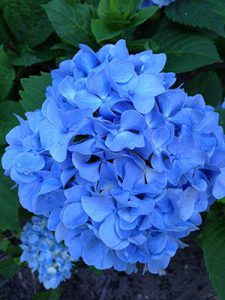
H. macrophylla
H. macrophylla, the old-fashioned hydrangea everyone’s grandmother grew, is truly one of the standouts in the shady, Southern landscape and commands attention when in flower. Sporting giant “mopheads” of inflorescences in gorgeous hues of blue (or pink, depending on soil pH), H. macrophylla is an extremely low maintenance plant, requiring only periodic irrigation and infrequent fertilizer; H. macrophylla even tolerates salt spray and can be grown on the Gulf Coast! By far, the greatest percentage of questions I receive concerning H. macrophylla involve plants not flowering because of pruning at the wrong time of year. For best flowering results, time pruning of once-blooming traditional cultivars like ‘Nikko Blue’ soon after flowering is finished in late summer. These plants set flower buds on the previous season’s wood; pruning older cultivars in the fall or winter may rejuvenate the plant but will prevent flowering the next year! Fortunately, over the last twenty years, advances in Hydrangea breeding have given gardeners the option of planting remontant cultivars that bloom on current season’s wood. Commonly sold remontant cultivars like ‘Endless Summer’, ‘Penny Mac’, ‘Bloomstruck’, and ‘All Summer Beauty’ have an early summer flower display like the traditional types but then continue to flower periodically throughout the rest of the summer! Even better, they may be pruned at any time without worry of damaging the next season’s flower show!
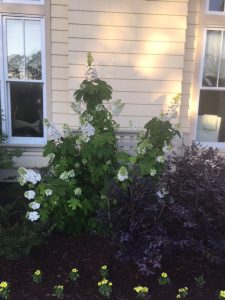
H. quercifolia (Oakleaf Hydrangea) Photo Courtesty of Andrea Schnapp
Those looking to diversify their hydrangea collection should next look to the native Oakleaf Hydrangea (H. quercifolia). The Oakleaf Hydrangea is a Florida native, growing wild on the steep, shady ravines along the northern end of the Apalachicola River. If the plants never flowered, the Oakleaf would be worth planting; its massive leaves, oak-shaped as the name suggests, can grow up to a foot in length and provide some of the best fall foliage color available to Floridians. However, the real show, as with all hydrangea species, are the flowers. This species flaunts 8”-10” white, panicle shaped flowers that are held elegantly above the coarsely textured foliage. In addition to these features, Oakleaf Hydrangeas couldn’t be easier to grow; obtaining heights up to 10’ and asking very little of the gardener other than adequate irrigation and some shade in the heat of the day! Look for the author’s favorite cultivars: ‘Alice’, ‘Semmes Beauty’, and ‘Snowflake’. Each of these cultivars and selections of the common species H. quercifolia perform very well in Northwest Florida.

H. paniculata ‘Quickfire’
Photo courtesy of Andrea Schnapp.
Finally, the newest hydrangea species introduced to Florida gardens, H. paniculata, has made significant inroads in the landscape industry over the last decade. Primarily grown as the cultivar ‘Limelight’, H. paniculata overcomes some of the weaknesses of the two aforementioned species, namely it tolerates full-sun and persists on much less water, making it a potentially more sustainable plant for many landscapes. This plant, like the remontant H. macrophylla cultivars, blooms on new wood and even seems to enjoy a hard pruning each winter; plants pruned this way seem to be more vigorous the next season and produce larger greenish-white flower panicles than unpruned specimens. Though it is a relative newcomer, H. paniculata, particularly ‘Limelight’, is a worthy addition to any landscape.
As you can see, there is a hydrangea for every yard and no true Southern landscape is complete without a few. When perusing your local garden center this summer, look for the selections and species mentioned above, plant properly, and enjoy the ensuing annual flower show for many years into the future! Who knows, you may be hooked by hydrangeas as I once was!

by Daniel J. Leonard | Feb 2, 2018
It is a common misconception that winter is a time of rest in the landscape, for both plants and people. In the Panhandle, the winter months tend to be rainy and miserable, with wild weather fluctuations in between. These conditions cause folks to think their chores are done until the weather warms up and plants begin to grow again. In reality, winter lays the foundation for the next year of growth! This is because, though most plants are dormant or have at least slowed their growth above ground, their root systems continue to develop through the cold. This “catch-up” time when plants are not growing above ground is the ideal time to plant woody trees and shrubs so they can focus their energy on getting a root system established without having to worry about supporting shoot growth! However, even if you plant at the proper time, several common mistakes can still torpedo your planting efforts. I once worked for a snarky nurseryman who, when new employees would ask how he wanted trees to be planted, would answer, “Green side up, of course.” So, remember to plant green side up and also keep the following in mind when you plant this winter!
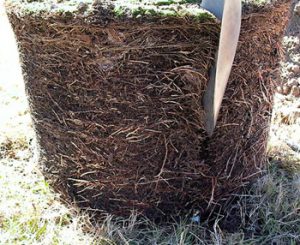
Cutting circling roots.
- Digging the right hole. The quickest way to resign a plant to failure before even removing it from the container is to dig a bad hole. In order to facilitate ideal root development and allow the plant to establish as rapidly as possible, the planting hole should be 2-3 times the diameter of the rootball. The easiest way to measure this is to set the plant were you want it and begin digging the hole around it; this step allows you to visualize the size of the hole. Most holes that are “eyeballed” are not wide enough. A little extra digging in the beginning can make a lot of difference later. In addition, the planting hole should be, at minimum, the same depth as the rootball. In a perfect scenario, after planting, the top of the rootball should be a half an inch to an inch higher than the surrounding soil to accommodate for settling of the soil underneath the rootball. This prevents the plant from sitting in a depression that water could pool in, leading to disease issues. It can be hard to believe, but simply digging a proper hole helps ensure plant establishment and enables long-term survival!
- Preventing Circling Roots. Often, plants are constrained in a container that is a little too small for a little too long on the floor of a nursery. When this situation occurs, the roots of the plant do not stop growing once they reach the “wall” of the container, but rather keep going in a circular pattern around the edge of the pot. This is a problem because, if not corrected, the roots will continue this growth pattern once in the ground, eventually strangling the plant. However, this problem is easily corrected by severing the circling roots. This is where gardeners often get squeamish however. It is time to check your plant conscience at the door and know the plant will thank you later! I like to make vertical slices, evenly spaced, around the rootball. These slices should cut about an inch into the rootball to ensure both superficial and unseen circling roots are cut; this somewhat brutal task can be accomplished with a sharp shovel, machete, or even a heavy-duty pair of pruners. At every cut, the previously circling root will branch, creating a nice web of new roots that will serve as anchors for the fledgling plant.
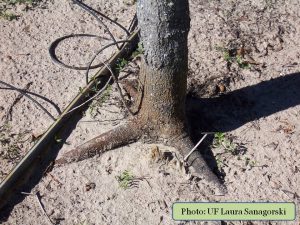 Backfilling Correctly. The single most asked question involving plants trees and shrubs is, “Should I backfill the hole with compost?” The single most common answer I give in return is, “Absolutely not.” Although it seems counterintuitive, it is almost never a good idea to backfill with a soil that is not your native soil. There is a simple reason for this. If a tree were planted in a hole that is backfilled with rich soil and is surrounded by our infertile, native Florida sands, why would it ever want to leave that hole? Turns out, it does not want to leave that easy environment because it has all the nutrients it needs right there, which is a problem. What happens when a drought, hurricane, or other stress event comes calling? The plant will not have a wide-spreading root system for support and will suffer from lack of water or lodging from high winds. By backfilling with your native soil, you encourage the plant’s roots to grow out and seek water and nutrients.
Backfilling Correctly. The single most asked question involving plants trees and shrubs is, “Should I backfill the hole with compost?” The single most common answer I give in return is, “Absolutely not.” Although it seems counterintuitive, it is almost never a good idea to backfill with a soil that is not your native soil. There is a simple reason for this. If a tree were planted in a hole that is backfilled with rich soil and is surrounded by our infertile, native Florida sands, why would it ever want to leave that hole? Turns out, it does not want to leave that easy environment because it has all the nutrients it needs right there, which is a problem. What happens when a drought, hurricane, or other stress event comes calling? The plant will not have a wide-spreading root system for support and will suffer from lack of water or lodging from high winds. By backfilling with your native soil, you encourage the plant’s roots to grow out and seek water and nutrients.
As you can see, there is a little more to planting than “green side up.” But, if you plant at the right time, dig the right hole, prevent circling roots, and backfill with your native soil, you will have set your newly bought tree or shrub up for success and will be able to enjoy it for many years to come! For more information on planting and other horticultural topics, contact your local UF/IFAS Extension office and as always, happy gardening!
by Daniel J. Leonard | Jan 10, 2018
Are you guilty of “Crape Murder”, the dreaded horticultural sin that involves lopping off your beautiful Crape Myrtles fence post high and creating gnarly looking knuckles? No need to raise hands, you know who you are! Despite the cruelness of this act, all is not lost; there is still time to repent and change your ways! The facts of the matter are, if you have made a habit of lopping the tops off your crapes, you are most definitely not alone, you probably thought you were doing the right thing, and it can be corrected.
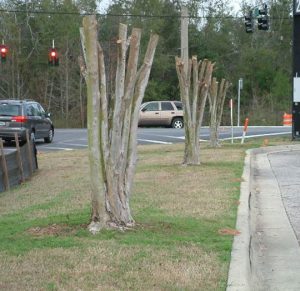
Improper pruning of crape myrtles. Photo Courtesy – Beth Bolles.
Crape Myrtle (Lagerstroemia spp.) are one of the most beautiful trees Southerners have in their horticultural arsenal. Unsurpassed in both form and flower, it is easy to see why Crape Myrtle is the most widely planted tree in the Southeastern United States. A mature Crape Myrtle properly grown is a remarkable sight, sinewy limbs reaching high in a vase shape supporting lilac-like flowers that come in a rainbow of colors. These qualities make it even more strange that homeowners and landscape professionals alike insist on butchering them every winter.
Before we move on to corrective procedures, let us examine a few of the reasons that crape murder is committed. First, I think peer pressure has a lot to do with it. When one sees every house on the street and all the business landscapes doing things a certain way, one tends to think that is the correct way. Second, there are folks who believe that pruning their crapes back each year creates a superior flower show. In reality, this practice creates an overabundance of succulent, weak, whippy branches (with admittedly larger flowers) that tend to bend over and break after a summer wind or rainstorm and are more prone to pests and disease. In addition, many homeowners over prune their crapes in this way because they planted a cultivar that grows too large for the site. There are dozens of crape myrtle cultivars sold, be mindful to pick one with a mature size and shape that will fit with the scale of the site!
So, now that we know why crape murder is committed, let’s discuss how to remedy it once the atrocity has already occurred.
- If the improper pruning has not been going on very long (a couple of years or less), it may be possible to correct over time without taking drastic measures. If this is the case, select two or three of the young “whippy” canes that are growing up and out and remove the rest. Ideally, the canes you select will be growing away from the center of the plant and not back into the middle of the plant or straight up to facilitate proper branch spacing as the tree continues to grow. The canes you select now will become primary branches in the years to come, so plan and prune carefully. Repeat for each main trunk that has been “murdered”. You will have to keep watch on the cut areas, as they will attempt to regrow as suckers after pruning; simply remove these juvenile shoots until they stop emerging.

Properly pruned crape myrtle. Photo courtesy – North Carolina Cooperative Extension
- If the murder has been going on for more than a year or two, it likely cannot be corrected without a major rejuvenation of the plant. Though it will likely be painful for you emotionally and seemingly run counterintuitive to your instincts, the best method to rejuvenate a disfigured crape is to break out the chainsaw and cut the plant back to the ground! This forces the plant to do one of two things; either grow an outrageous number of new shoots or die. In most cases however, the crape myrtle’s tough constitution permits it to regrow from the stump. The first growing season after performing this procedure, allow the shoots that sprout to grow and do not prune. The winter following the first growing season, remove all except three to five strong, well-spaced shoots and allow these to become the new plant’s main trunks. In all succeeding years, only prune to remove dead wood, crossing branches and branches growing toward the center of the plant.
If you have been guilty of crape murder, it is not too late to change your ways! Follow these steps, get out and enjoy the cool weather, and get to correcting your mistakes while the plants are still dormant! As always, if you have any questions about the topic of this article or any other horticultural topics, please contact your local Extension office and happy gardening!
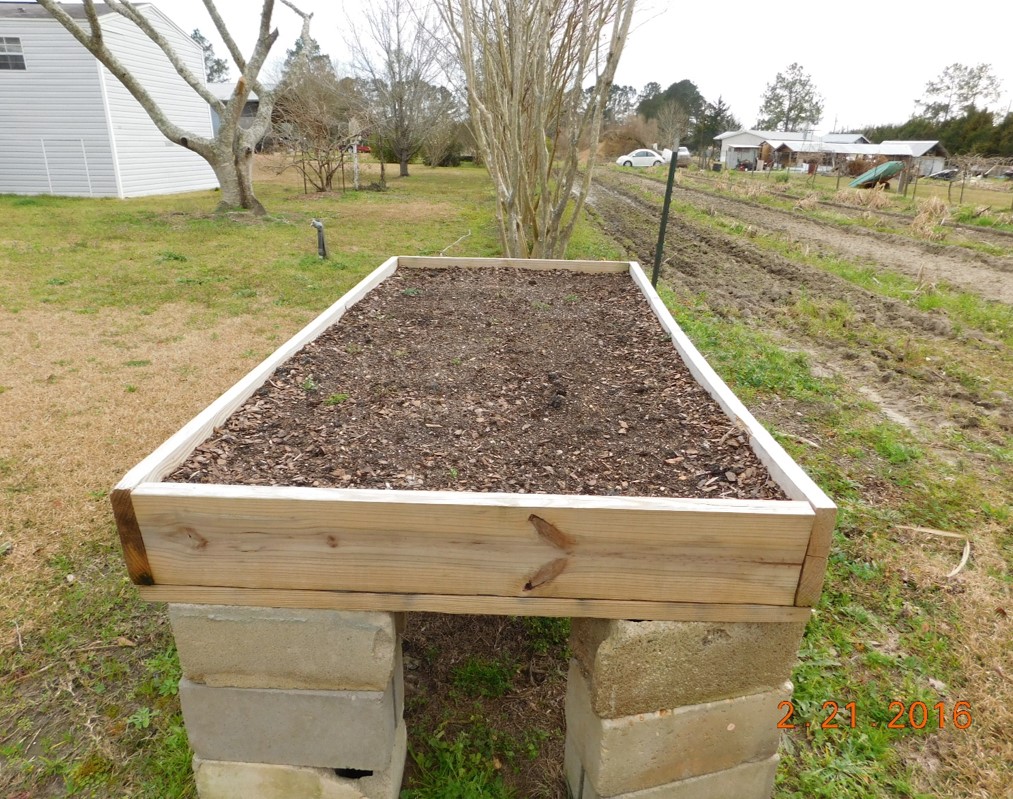
by Daniel J. Leonard | Oct 10, 2017
I had to do a hard thing last week. My battle-worn okra, eggplant and pepper plants that had produced so reliably since June and endured all the summertime challenges (heat, insects, disease, and a hurricane to name a few) were finally pulled out of my raised bed garden and discarded. A combination of lowered yields, increased insect pressure, and the fact that one can only eat so much okra in a calendar year sealed their fate.
However, before planting our cool-season veggie favorites, like those tender leafy greens and wonderfully crunchy carrots, there are a few things to do to get our raised beds in shape to give maximum yield performance and make growing a little easier.

Replenish the Soil
One of the main benefits of raised beds is the ability to grow in near-perfect soil conditions. If I was relegated to gardening in my yard’s less than ideal native sandy soil, I might have given up altogether by now and I suspect many of you would be in the same boat. Raised beds totally alleviate this problem and give gardeners the opportunity to grow in rich, fertile soil composed of your favorite homemade soil mixture (mine is two parts mushroom compost to one part aged pine bark) or commercial potting mix/compost. However, at the end of each growing season, you will notice you have a bit less soil in your beds than you did at the beginning. While frustrating, this is a natural process for soils rich in organic material – they naturally break down and decompose! So to give your veggies’ roots the maximum amount of growing space for the coming season, top off your beds with a quality soil/compost mix and till it in before sowing seed or setting out transplants.
Eliminate Competing Roots
If you have a mature tree anywhere near your raised bed garden, you are going to be in for a surprise when you till that new compost in! It turns out that tree roots like that rich, fertile raised bed soil just as much as vegetables do and will seek it out. It is not uncommon for mature trees to have root systems that stretch horizontally two to three times the height of the tree, meaning a 50’ oak tree could have roots growing well over a hundred feet away from its trunk! Therefore, unless you have a totally tree-free property, battling tree roots in your beds will be an ongoing issue. For instance, each fall, when I transition from warm season to cool season crops, I find that my neighbor’s Laurel Oak has filled all three of my raised beds full of feeder roots glad to be free of the infertile sand. This is a problem because those roots suck up vital water and nutrients meant for my vegetable crops, robbing them of reaching their full potential. It is good practice to thoroughly till your beds’ soil and remove as many of the competing roots as you can. Doing so will give your new plants a head start on becoming established before the competition returns.
Depleted soil and competition from tree roots are two of the biggest threats to your raised bed’s performance. By planning ahead and accounting for both of these things prior to planting your fall garden, you will be more likely to reap a larger yields when harvest time comes! For more information on raised bed vegetable gardening and other horticultural questions, contact your local UF/IFAS Extension Office. Happy fall gardening!
by Daniel J. Leonard | Aug 25, 2017
Northwest Floridians are lucky. We get to bask in the warm sunshine at least eight months of the year, consider it cold weather when we have to break out the fleece pullover and none of us live more than a few hours’ drive to the whitest sand you ever saw. However, those conditions have consequences. That warm sun and plentiful rain yields heat and humidity, a perfect breeding ground for all manner of pests and diseases, not to mention seriously cutting down on necessary chill hours required by many species. We’ll never be able to grow peaches like they do in Georgia. No one is in any danger of mistaking a Florida apple for one from Michigan. Pomegranates, olives, and nectarines like California? Forget about it. All of those species will mostly survive and grow but in most cases, the inputs of labor and protective chemicals greatly outweigh the output of fruit. For most of us it is just not worth the time and effort to turn a crop!
We have a couple of adapted, well-known stalwarts to turn to though. Any gardener worth his salt has a few productive rabbiteye blueberries (Vaccinium ashei), a pear (Pyrus communis), an old reliable fig tree (Ficus carica), and a citrus or two of some kind (though with the devastating disease known as Citrus Greening looming on the horizon, backyard citrus may decline in popularity in the near future). However, hobby fruit growers aren’t often content to stick to those standards though. We tend to be an adventurous, progressive lot, always looking for new species to grow and constantly pushing climatic and adaptation limits of species, with varying success. For the Panhandle backyard fruit orchardist looking for a little variety but demanding a high probability of success, there are three unusual Florida Friendly trees requiring little winter chill that fit the bill perfectly: Pawpaw (Asimina triloba), Japanese Persimmon (Diospyros kaki), and Loquat (Eriobtrya japonica).
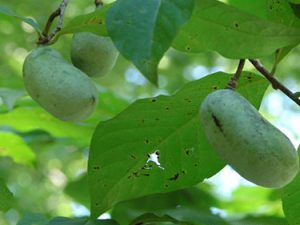
Pawpaw fruit
The pawpaw (yes it’s pronounced exactly like you think it is) is an altogether unusual tree. For starters, it is one of the most adaptable plants in cultivation, growing native from New York all the way down to the Sunshine State. It would be a beautiful tree if it never produced a single fruit; the large leaves droop naturally, lending a decidedly tropical feel to the garden and the understated purple-brown flowers are some of the more attractive of our native spring blooming trees. But, to be sure, the fruit are the real attraction here. Technically berries, the bluish-green, three to five inch long, oval-shaped fruit ripen in the late summer (August-October) and have an extremely unique taste often likened to banana or custard. Pawpaws occur naturally in moist, well-drained soils and thrive in both shade and sun; site accordingly and this unusual little native fruit tree should perform admirably for you!
While more common than Pawpaw, Japanese Persimmon still has not reached the cosmopolitan status of pear or fig or the like for reasons unclear to me! Native to eastern Asia, Japanese Persimmon is right at home in the Panhandle where it rewards gardeners each fall with outstanding reddish/orange foliage and a reliable crop of beautiful, baseball-sized, orange fruit possessing a crisp, sweet taste that can be eaten fresh or used in cooking. I especially like the fruit when it is made into a cakey “bread” similar to banana bread. It is a remarkably forgiving tree, growing and fruiting reliably with little help from the orchardist. Japanese Persimmon is generally sold as one of the selected cultivars, ‘Fuyu’ being the most common and probably the best. The species prefers full sun and moist, well-drained soil but does just fine without irrigation once it reaches establishment. A bonus, you only need to plant one as Japanese Persimmon does not require a pollinator! (Note: Persimmons can be astringent or non-astringent. If you plant an astringent cultivar, be sure to let the fruit ripen completely before eating as they are unpalatable until that point. Most are probably better off going with a non-astringent cultivar such as ‘Fuyu’.)
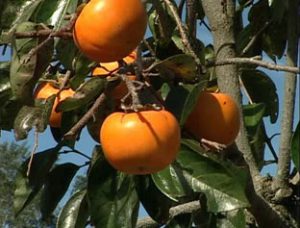
Persimmon fruit
A lesser-known gem of the coastal south, Loquat is hard to beat. It’s a great addition to the landscape, the cinnamon colored bark, foot-long “cabbagey” textured leaves and early spring flowers outdo many purely ornamental species. The yellowish-orange fruit that follow are outstanding picked and eaten fresh off the tree. Flavor is reminiscent of citrus with a sweet taste and a soft texture. Loquat flourishes in full sun and once established needs little to no supplemental fertilization or irrigation. As with Japanese Persimmon, Loquat is self-fertile and does not need a pollinator so just one tree will do (trust me, one healthy loquat will make enough fruit to feed a small army)!
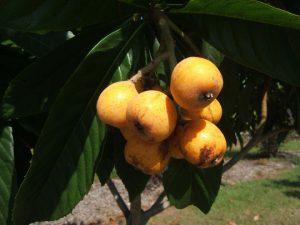
Loquat fruit
If you are indeed a backyard orcharding enthusiast and want to expand your horizons to include more than the same old standard species that everyone else grows or maybe you’re just frustrated with trying to grow popular but ill-adapted species like peach and apple, you could do a lot worse than including one or all of Pawpaw, Japanese Persimmon, and Loquat into your garden! For more information on fruit trees and any other horticultural questions you may have, contact your local UF/IFAS Extension office. Happy gardening!







 Backfilling Correctly. The single most asked question involving plants trees and shrubs is, “Should I backfill the hole with compost?” The single most common answer I give in return is, “Absolutely not.” Although it seems counterintuitive, it is almost never a good idea to backfill with a soil that is not your native soil. There is a simple reason for this. If a tree were planted in a hole that is backfilled with rich soil and is surrounded by our infertile, native Florida sands, why would it ever want to leave that hole? Turns out, it does not want to leave that easy environment because it has all the nutrients it needs right there, which is a problem. What happens when a drought, hurricane, or other stress event comes calling? The plant will not have a wide-spreading root system for support and will suffer from lack of water or lodging from high winds. By backfilling with your native soil, you encourage the plant’s roots to grow out and seek water and nutrients.
Backfilling Correctly. The single most asked question involving plants trees and shrubs is, “Should I backfill the hole with compost?” The single most common answer I give in return is, “Absolutely not.” Although it seems counterintuitive, it is almost never a good idea to backfill with a soil that is not your native soil. There is a simple reason for this. If a tree were planted in a hole that is backfilled with rich soil and is surrounded by our infertile, native Florida sands, why would it ever want to leave that hole? Turns out, it does not want to leave that easy environment because it has all the nutrients it needs right there, which is a problem. What happens when a drought, hurricane, or other stress event comes calling? The plant will not have a wide-spreading root system for support and will suffer from lack of water or lodging from high winds. By backfilling with your native soil, you encourage the plant’s roots to grow out and seek water and nutrients.




